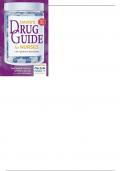Exam (elaborations)
DAVIS’S DRUG GUIDE FOR NURSES 15th Edition - Test Bank
- Course
- Institution
Drug Guide Test Bank MULTIPLE CHOICE 1. The nurse is providing care for a patient scheduled to take Precose (acarbose) 25 mg three times daily with meals. The patient reports feeling sweaty, weak, and tremulous. Which of the following actions by the nurse is best? A. Reassure the pati...
[Show more]



